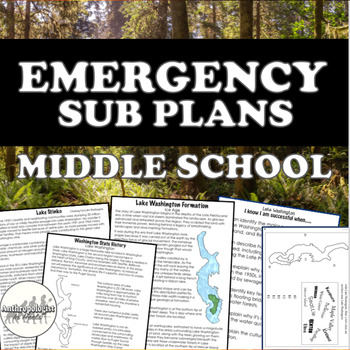Emergency Middle School Social Studies Sub Plans Bundle Google + PDF
- Zip
Products in this Bundle (14)
showing 1-5 of 14 products
Description
You are viewing emergency sub plans for middle school social studies. These emergency sub plans, available in google slides and PDF, explore topics such as native American history, working at Starbucks, the science of the Cascadia subduction zone, evolution, plate tectonics, Bering land bridge theory, ice ages and even fossil database web-quest.
This set of Emergency Sub Plans for Middle School Social Studies offers convenient access to resources in both Google Drive and PDF formats, along with curated YouTube libraries. These comprehensive plans are designed for immediate use during unexpected absences or last-minute lesson needs. Each activity is carefully curated to ensure educational continuity and engagement, providing a hassle-free resource for substitute teachers and educators. Whether you prefer digital access via Google Drive or printable PDFs, these ready-to-use sub plans offer flexibility and convenience. Be prepared for any situation with this comprehensive resource tailored specifically for middle school social studies classrooms!
Student Profile: 6th, 7th, 8th grades.
Teacher Profile: You teach middle school social studies or Washington State history.
You Get:
- Cascadia Subduction Zone
- Lake Washington – a Stinky Clean-up
- Who was Chief Seattle
- Constitution Day – reading the Preamble
- Labor Day – Child Labor and the New Deal
- Introduction to the Bering Land Bridge
- Extinct Animal Informative Writing and Group Presentation
- Marsupial Lion, extinct animal study
- Working for lattes! An employment and latte making activity
- Introduction to Evolution
- Mass Extinctions! Extinctions of the Pleistocene
- More as I continue to add them!
BUNDLES
Washington State History Bundle | Grade 7 ✩₊̣̇. ੈ♡˳ ✧
Native American Heritage Month Art BUNDLE
Native American Heritage Month BUNDLE
Native American Tribes and Indigenous Peoples BUNDLE
Hominin Evolution | Human Evolution Complete Lesson GROWING BUNDLE!
Physics BUNDLE | Activities & Curriculum
Native American Clip Art Growing Bundle
Ukrainian ESL Growing Bundle |
Indigenous People | Haida Art BUNDLE
Introduction to Business and Marketing Bundle
Reading Comprehension Bundle for Chinese Students
Reading Comprehension Bundle for Spanish Speaking Students
Reading Comprehension Bundle for Vietnamese Students
Reading Comprehension Bundle for Arabic Students
Persian-English Language Learners: ESL, ENL, ELL | English immersion





